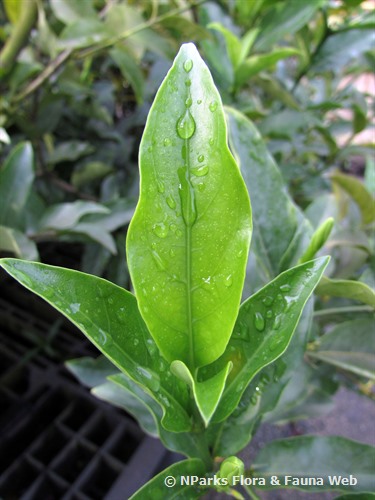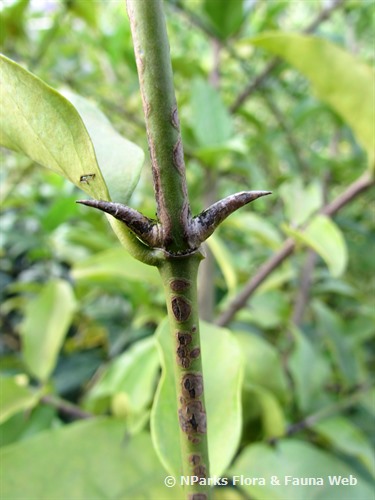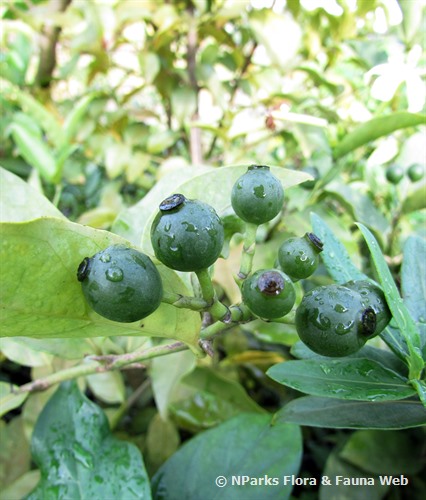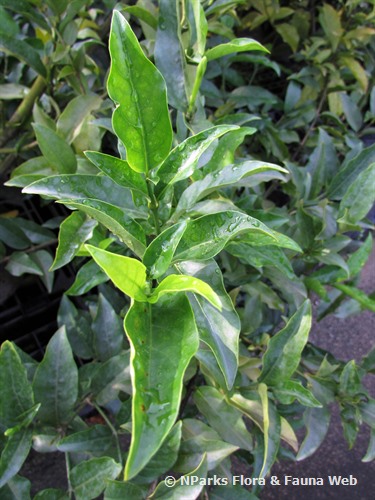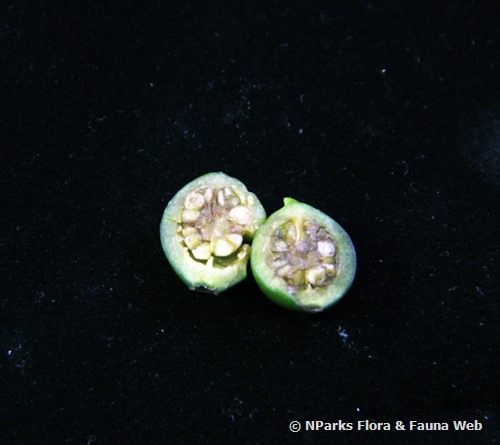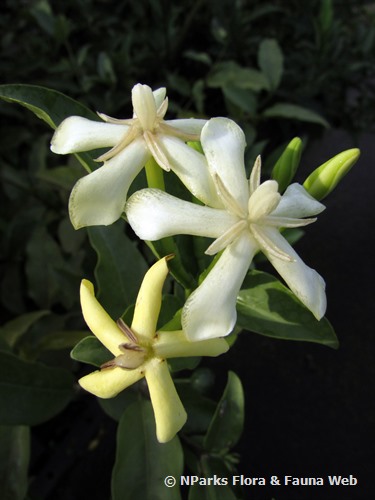
Name
Classifications and Characteristics
| Plant Division | Angiosperms (Flowering Seed Plants) (Dicotyledon) |
|---|---|
| Plant Growth Form | Climber, Shrub |
| Lifespan (in Singapore) | Perennial |
| Mode of Nutrition | Autotrophic |
Biogeography
| Preferred Climate Zone | Tropical |
|---|---|
| Local Conservation Status | Native to Singapore (Vulnerable (VU)) |
Description and Ethnobotany
| Growth Form | It is a semi-woody climber with straggling growth habit. |
|---|---|
| Foliage | Leaves are arranged oppositely along the stem, ovate-shaped, slightly wavy margin, and has pinnate venation. |
| Stems | Woody, stems and branches have sharp curved thorns which are almost hook-like to allow them to latch on other plants when it climbs. The thorns are located at the leaf nodes. |
| Flowers | Flowers are borne on clusters (called as inflorescence), umbel type. Each flower is tubular-shaped, measures at least 4 cm long and 3 cm across, fragrance similar like jasmine, petals white and then to yellow when mature. |
| Fruit | Fruits are small and berry-like, round-shaped, and green in colour. |
| Habitat | Commonly found at the back mangroves. |
| Cultivation | Can be trained into a shrub. Pruning has to be done carefully as the climber has sharp spines on the leaf axils. |
| Etymology | The genus Oxyceros means sharp-horned, which refers to the plant thorns. The specific epithet longiflorus means long flowers. |
Landscaping Features
| Desirable Plant Features | Fragrant (Flowers) (Time Independent) |
|---|---|
| Usage Hazard - Cons | Spines/Thorns - Stem/Branch |
Fauna, Pollination and Dispersal
| Fauna Pollination Dispersal Associated Fauna | Butterfly-Attracting (Flower Nectar) |
|---|
Plant Care and Propagation
| Light Preference | Full Sun |
|---|---|
| Water Preference | Moderate Water |
| Rootzone Tolerance | Moist Soils |
| Propagation Method | Seed, Stem Cutting |
Foliar
| Foliage Retention | Evergreen |
|---|---|
| Mature Foliage Colour(s) | Green |
| Foliar Modification | Spine (axillary) |
| Foliar Type | Simple / Unifoliate |
| Foliar Arrangement Along Stem | Opposite |
| Foliar Attachment to Stem | Petiolate |
| Foliar Shape(s) | Non-Palm Foliage (Ovate) |
| Foliar Venation | Pinnate / Net |
| Foliar Margin | Entire - Wavy / Undulate |
| Foliar Apex - Tip | Acute |
| Foliar Base | Rounded / Obtuse |
Floral (Angiosperm)
| Flower & Plant Sexuality | Bisexual Flowers |
| Flower Colour(s) | White, Yellow / Golden |
|---|---|
| Flower Grouping | Cluster / Inflorescence |
| Flower Location | Terminal |
| Flower Symmetry | Radial |
| Individual Flower Shape | Tubular |
| Inflorescence Type | Umbel |
| Flowering Period | Free-Flowering |
| Flower Colour(s) Remarks | White at first, and turn to yellow as matures. |
Fruit, Seed and Spore
| Fruit Classification | Simple Fruit |
|---|---|
| Fruit Type | Fleshy Fruit |
Image Repository
Others
| Master ID | 32973 |
|---|---|
| Species ID | 7387 |
| Flora Disclaimer | The information in this website has been compiled from reliable sources, such as reference works on medicinal plants. It is not a substitute for medical advice or treatment and NParks does not purport to provide any medical advice. Readers should always consult his/her physician before using or consuming a plant for medicinal purposes. |

.jpg)
.jpg)
